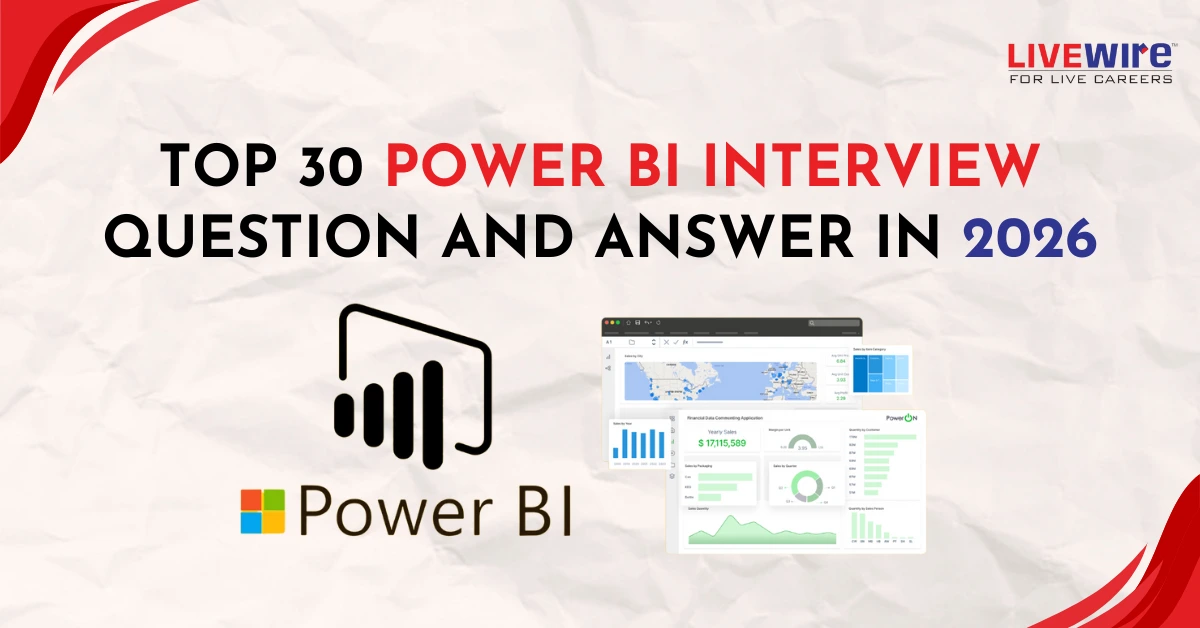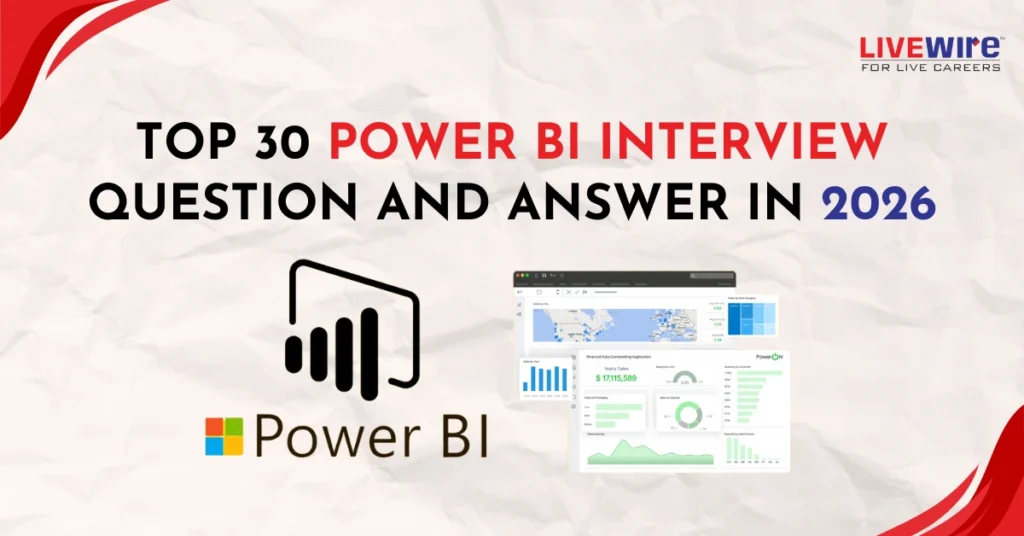Power BI is one of the best and most popular business intelligence tools in 2026. This guide consists Top 30 Power BI Interview Questions and Answers, Which will Basically help the learners to improve their analytics of data, Visualization of data and Visualization skills.
As businesses depend on insights, professionals need to know how to work with Microsoft Power BI, DAX, the concepts of modeling and reporting. Moreover, the user friendly nature of the platforms allows beginners to learn and implement real-world data analytics on Power BI.
Contents
- 1 Power BI Interview Questions and Answer for Freshers
- 2 Data Analytics Course in Chennai
- 2.1 3. Difference between Power BI and Tableau
- 2.2 4. What are the different types of visualization techniques in Power BI?
- 2.3 5. What are the differences between Power Query and Power Pivot?
- 2.4 6. What is a calculated column in Power BI?
- 2.5 7. What is a measure in Power BI?
- 2.6 8. What are the different languages used in Power BI?
- 2.7 9. What are the most common data-shaping techniques?
- 2.8 10. What are custom visuals in Power BI?
- 3 Power BI Interview Questions and Answers For Intermediate Level
- 4 TOP 10 POWER BI TRAINING INSTITUTE IN CHENNAI[2026]
- 5 TOP 30 POWER BI INTERVIEW QUESTION AND ANSWER IN 2026
- 6 Top UI/UX Design Trends in 2026
- 6.1 2. What are the three fundamental concepts of DAX?
- 6.2 3. Why and how would you use a custom visual file?
- 6.3 4. What are the categories of data types?
- 6.4 5. Explain Responsive Slicers in Power BI.
- 6.5 6. What is "M language"?
- 6.6 7. Can you give an example of a DAX function?
- 6.7 8. What is a Power BI workspace?
- 6.8 9. Explain the difference between SUM and SUMX in DAX.
- 6.9 10. What is the difference between DirectQuery and Import mode?
- 7 Power BI Interview Questions And Answers for Experienced
- 8 Data Science using Python in Chennai
- 8.1 3. What is a Star Schema and why is it recommended in Power BI?
- 8.2 4. What is a Calculation Group in Power BI?
- 8.3 5. How do you use the Performance Analyzer?
- 8.4 6. How do you design a Power BI data model for enterprise-level reporting?
- 8.5 7. Name the variety of Power BI Formats?
- 8.6 8. What gateways does Power BI have and why should you use them?
- 8.7 9. What are KPIs in Power BI?
- 8.8 10. How do you reduce high-cardinality columns?
Power BI Interview Questions and Answer for Freshers
1. What is Power BI?
Power BI is a business intelligence tools with a powerful data modeling and visualization engine developed by Microsoft. It enables users to transform raw data into interactive and dynamic dashboards and reports.
With Power BI offering capabilities for data modeling, data visualization, as well as real-time sharing and collaboration. It has integrated a lot of features such as Power Query, DAX and very customizable visuals.
2. Why should we use Power BI?
First of all, for non-technical users to work with the data easily, Power BI has user friendly interfaces. Second, it connects to hundreds of data sources, so you can do more complex data analysis with Power BI. Third, Power Bi is cheaper than other BI tools.
Other compelling reasons include built-in security features such as Row-Level Security (RLS), activity logs, and governance. Since companies are data-driven, Power BI enables them to get the right insights to make decisions faster.

Gain Hands-On Knowledge from Trainers Who Manage Real-World Data Projects.
3. Difference between Power BI and Tableau
Power BI and Tableau are two widely used business intelligence tools, but the objectives and capabilities of these tools are not the same. Power BI is more user friendly for beginners but Tableau is certainly more for the technical user.
In addition, Power BI provides superior governance and easier sharing with Power BI Service. Both products are currently featuring highly advanced dashboards, however, Power BI has gained more traction thanks to its affordability and much more massive community support.
4. What are the different types of visualization techniques in Power BI?
Power BI has a number of different visuals available to allow for strong visualisation skills such as bar and line charts, pie charts, maps, tables, matrices, cards and funnels. The visualization types such as slicers, KPIs, gauges, decomposition trees can be made available.
Power BI has AI visuals, including Key Influencers and forecasting, enabling users to more quickly discern patterns. Custom visuals can also be uploaded through AppSource. These features are included in the overall user experience along with tooltips, drill-through, bookmarks and conditional formatting.
5. What are the differences between Power Query and Power Pivot?
Power Query is the tool for extracting, cleaning and transforming data. It can be thought of as preparing raw data before loading to model. Power Pivot, on the other hand, is all about data modeling and calculations with DAX. Power Query is M language and Power Pivot is DAX formula.
Power Query takes care of processes like deduplicating, joining tables, and shaping data. Power Pivot supports relationships, hierarchies and complex calculations. Though they work under Power BI, they are meant for different things. Power Query is the ETL, Power Pivot is the modelling engine.
6. What is a calculated column in Power BI?
A calculated column is a new column that you add to an existing table in the data model that uses a DAX formula that is evaluated for each row. Calculated columns are calculated row by row and are physically stored in your model. Calculated columns are great when you want to categorize data or generate values that you can use as a slicer.
A calculated column can be used, for example, to differentiate sales categories or to determine if a date falls on a weekend. Unlike measures, calculated columns are not dynamic – they do not change according to the applied filters or the context.
7. What is a measure in Power BI?
A measure in Power BI is a dynamic calculation, defined using DAX. Measures, on the other hand, are not physically stored like they are calculated when they are used. They don’t calculate over a snapshot of data like a calculated column or a measure, but rather on results that are filtered on by visual.
Measures are a must if you want to define KPIs, totals, averages, ratios, time-intelligence calculations, and so on. Measures add dynamism and interactivity to dashboards.
8. What are the different languages used in Power BI?
Power BI employs several languages for advanced analytics. These include:
9. What are the most common data-shaping techniques?
Data shaping refers to the tasks you perform in Power Query to get the data ready for modeling.Common techniques consist of:
- Filtering rows and columns
- Removing duplicates
- Splitting or merging columns
- Grouping data
- Pivoting and unpivoting
- Changing data types
- Creating custom columns
10. What are custom visuals in Power BI?
Custom visuals are custom-made visual components developed with Java Script, JQuery, or TypeScript. They build on the functionality of standard visuals. Developers or companies develop custom visuals to serve niche scenarios such as heatmaps, complex KPIs or financial charts.
These visuals can be imported by users from Microsoft AppSource.They increase the flexibility of dashboards and the level of engagement of users.
Power BI Interview Questions and Answers For Intermediate Level
1. What is DAX?
DAX (Data Analysis Expression) is a formula expression language used in Power BI, Power Pivot and SSAS Tabular models. It allows the user to create calculation and expressions that can be used to enhance the data model.
DAX is critical to measures, calculated columns, and tables. DAX is used to apply business rules, to execute time intelligence and to calculate dynamic KPIs.
2. What are the three fundamental concepts of DAX?
The three concepts of DAX include:
- Syntax – The structure of a formula
- Functions – Predefined operations such as SUM, AVERAGE, or COUNT
- Context – Including Row Context and Filter Context
3. Why and how would you use a custom visual file?
Custom visuals are created in situations where the standard visuals do not meet the reporting requirements. For instance, financial dashboards may need to incorporate waterfall charts or bullet graphs.
This offers users greater flexibility, and allows for more innovative display. Firms usually prefer custom visualizations to develop unique storytelling approaches and concentrate on specific metrics.
4. What are the categories of data types?
Power BI supports several data types such as:
- Whole Number
- Decimal Number
- Fixed Decimal
- Date/Time
- Text
- Boolean
- Currency
5. Explain Responsive Slicers in Power BI.
Responsive slicers in Power BI change their layout depending on the space available. They guarantee that dashboards are as easy to use on mobile phones and other small form factor usage as on desktop screens. When I am shrinking a slicer too much I see icons instead of full view.
This feature increases the usability and keeps dashboards clean. Responsive slicers offer a better user experience, especially in mobile reports . Companies love this feature as it gives a much better user experience on different devices. 33
6. What is "M language"?
The Power Query Formula Language informally known as M is a mashup language to perform data transformation. It lets users clean, reshape and format data prior to loading into the model. M language also supports advanced functions such as querying data by merging queries, adding custom columns, filtering data on the fly.
7. Can you give an example of a DAX function?
A common DAX example is:
- Total Sales = SUM(Sales[Amount])
This measure calculates the sum of sales amounts across the dataset. Another example:
- Sales LY = CALCULATE(SUM(Sales[Amount]), SAMEPERIODLASTYEAR(Date[Date]))
This helps compare sales year-over-year and is widely used in dashboards.
8. What is a Power BI workspace?
A Power BI workspace is a Get Data environment in Power BI , in which you can publish reports, manage reports, and collaborate with others on reports and dashboards. Organizations utilize workspaces to manage access, roles, and the project files within.
Workspaces enable secure sharing of content, building apps and integration with Power BI Service. They’re critical for collaborating in teams and reporting at scale.
9. Explain the difference between SUM and SUMX in DAX.
SUM just adds up the values in a column, whereas SUMX goes row by row and then sums up the results. SUMX is the correct approach when you need to do row level logic in a calculation. For instance, if you want to multiply quantity by price in each row and then add up the results, you need to use SUMX.
10. What is the difference between DirectQuery and Import mode?
Import Mode:
- Data is stored in Power BI memory
- Best performance
- Supports full DAX features
DirectQuery:
- Data stays in the source
- Real-time querying
- Slower compared to Import
- Some DAX limitations apply
Power BI Interview Questions And Answers for Experienced
1. What are the major differences between visual-level, page-level, and report-level filters in Power BI?
Visual-level filters affect only one visual, page-level filters affect the whole report page, and report-level filters affect all pages in the report. Power users Specify the filter type that they require for their report based on their needs.
2. Explain Row Context vs Filter Context.
Row Context is a calculation evaluated for each row. Filter Context is created when you apply a filter to a visual or in a DAX function. Both these contexts are employed by DAX when it calculates how values are aggregated.
Time-intelligence, dynamic KPIs and complex calculations require a good understanding of the context.

Livewire offers practical Python for Data Science training with certification and placement support.
3. What is a Star Schema and why is it recommended in Power BI?
A Star Schema is a type of Power BI data modeling that is used to map fact tables to dimension tables. It is recommended to simplify relationships, enhance performance, and enable more efficient microsoft power bi data modeling.
Star Schemas increase query speed, and are industry standard. Professionals trust Star Schemas for enterprise reporting.
4. What is a Calculation Group in Power BI?
Calculation Groups eliminate the repetition by combining calculations that are like YoY, MoM or QoQ. They aid in controlling the complexity of the model and ease writing DAX.
The creation of Calculation Groups is done by Tabular Editor and they enhance the scalability. They are employed by enterprise to ensure consistent calculations across many reports.
5. How do you use the Performance Analyzer?
The Performance Analyzer is a feature in Power BI Desktop that collects and displays information about the query and visual performance. It showcases slow visuals, bad DAX, and transforming on steroids.
Users can export logs and investigate to improve responsiveness of the report. Because speed is so important in analytics, this utility has been a staple on enterprise dashboards for years.
6. How do you design a Power BI data model for enterprise-level reporting?
The enterprise models are built following best practices like Star Schema design, relationships, DAX optimized, and security managed. Designers leverage incremental refresh, aggregation tables and active directory RLS for governance.
It is also important to remove unneeded columns, optimize data types, and be consistent. Domain modeling enhances scalability and processing time.
7. Name the variety of Power BI Formats?
Power BI includes formats such as:
- Power BI Desktop (.pbix)
- Power BI Template (.pbit)
- Dataflow (.json)
- Custom Visual Files (.pbiviz)
- Power BI Paginated Reports (.rdl)
8. What gateways does Power BI have and why should you use them?
Power BI provides two types of gateways:
- Personal Gateway
- Enterprise Gateway
Gateways enable a secure data flow between on-premise data sources and the Power BI Service. Enterprises leverage gateways for scheduled refreshes, data consistency, and secure access and communication.
9. What are KPIs in Power BI?
KPIs (key performance indicators) measure the progress of business goals. Power BI has KPI visual to show actual and target values for comparison. KPIs allow stakeholders to track performance, spot trends, and make data-driven decisions.
For instance, working out the quarterly revenue versus its target is an effective use of KPIs. Good KPI design enhances Power BI dashboard readability.
10. How do you reduce high-cardinality columns?
- Split DateTime into Date + Time
- Group free-text columns
- Instead of using GUID keys, use numeric surrogate keys.
- Trim unique large text fields

![TOP 10 POWER BI TRAINING INSTITUTE IN CHENNAI[2026]](https://livewiresoftwarecourses.com/wp-content/uploads/2025/11/power-bi-training-in-chennai.webp)

![TOP 10 POWER BI TRAINING INSTITUTE IN CHENNAI[2026]](https://livewiresoftwarecourses.com/wp-content/uploads/2025/11/power-bi-training-in-chennai-1024x536.webp)

